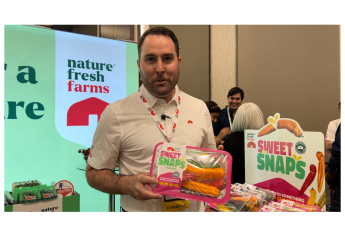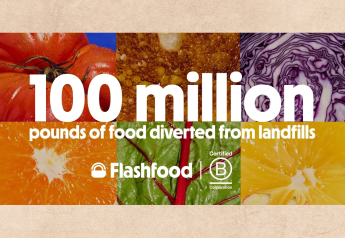Salinas Valley growers get nimble to address supply gaps

If the salad bowl of the world were a bustling restaurant, the chef would be in the weeds right now.
Assessing demands and lining up a steady supply of orders timed perfectly, amid a rush of customers, demands the laser focus and nimble creative problem-solving skills of a masterful chef — or farmer.
That’s essentially the scenario playing out for growers in California’s Salinas Valley. Consecutive floods during Salinas Valley’s typical early planting periods have caused harvest delays that will continue to ripple through the supply chain in the coming months.
That’s making central California growers put their skills to the test to ensure a steady supply despite downstream challenges.
Tallying storm damages
In addition to keeping up with supply, growers are scrambling to assess the cumulative damage to acreage and infrastructure affected by recent flooding. Accounting for losses presents a complex web of factors for growers, agency officials and lawmakers to consider in the recovery from the unprecedented weather events.
The Monterey County Agriculture Commission will have to take into consideration not only the January flooding event, where most of the damages were attributed to future crop loss, but also the second storm in March, Grower-Shipper Association of Central California President Christopher Valadez told The Packer.
“[The March storm] flooded not only those same lands again, but also affected more and different acreage,” Valadez said. “In March, many farmers had crops planted, unlike January. Whether you had crops planted or you didn't have crops planted, you were either were flooded again or flooded anew. It basically extended the clock and lengthened the delay to when you can get in that field again.”
The kicker is that, unlike commodity crops, most specialty crops like lettuce and short-season vegetables don’t have crop insurance to cover losses.
Related news: What's ahead for California table grapes, strawberries and cherries
“There's a gap regarding relief services or direct financial relief for farming operations that were directly impacted by floods. The type of row crop grown … corresponds to what the income is for that acreage which bears that crop,” Valadez said. “The [crop insurance] programs that appear to exist don't fit well with the disaster related needs — they're getting missed.”
Avoiding supply gaps
While U.S. lawmakers are currently pressing for a disaster relief package in Congress to help farms and ranches recover from storm and flooding damage, many growers are finding creative ways to solve for gaps in harvest.
“[Growers] are going to have to flex out and identify some other options so that we care for our customer base and to continue to offer and provide the supply that we're contracted to provide,” Valadez said.
Growers in the Salinas Valley are nimble and are accustomed to creative problem-solving. An unexpected silver lining in the recent impatiens necrotic spot virus crisis in Salinas during the 2022 season was that it incentivized growers to diversify their planting regions, according to Valadez.
Related news: Grower-shipper group aids farmworker community in flooding aftermath
“For those that were able to accelerate their diversity, the disease issue pushed to them to step up the pace of that acceleration. That happened before the flood,” he said. “Even though [the flooding and recent INSV issues] are different, both ultimately negatively impacted yield.
“So, you have farming operations — fortunately or unfortunately — that have very recent experience knowing where they're able to reduce their risks by diversifying the variety of [growing] regions from which they're deriving their supply,” Valadez continued.
While none of the adjacent growing regions will replace the Salinas Valley supply, largely due to sheer scale and magnitude of the region, these supplementary regions can help alleviate gaps in years like this one, he added.
“Growers that have flexibility have been working through these challenges and some have put themselves in better positions — relatively speaking — from a resiliency perspective,” Valadez said. “They're able to continue to work with their customers to identify where the continuity of their supply is coming from.”
The Nunes Company’s John Amaral is confident that they will get through what is shaping up to be a challenging transition this year, reporting that the company is currently harvesting vegetables out of the Oxnard and Salinas growing regions under the Foxy and Foxy Organic brands.
“Everyone has had differing degrees of losses due to the weather in the Salinas Valley,” Amaral told The Packer. “Our operations were impacted like many within the industry. We are dealing with planting delays but overall are in good shape and anticipate no issues in the ability to provide quality products to our customers.”
Unseasonably cold temperatures in February and March disrupted the normal growing cycle, putting the grower behind schedule, Amaral added.
“Every year is different, and each transition is different with its own challenges and opportunities,” he said. “The transition from Yuma [Ariz.] to Salinas has been unprecedented due to the colder-than-normal temperatures and greater-than-normal rainfall.”
Muzzi Family Farms, which grows in central California, Yuma and Mexico also anticipates a challenging few months ahead.
“When fields are flooded by the river in January, food safety protocol requires waiting 30 to 60 days. That waiting period clock started over when we got the second flood in March,” Paul Mocettini, vice president of sales at marketing at Muzzi Family Farms, told The Packer.
To ensure a consistent supply, like The Nunes Company, Muzzi Family Farms delayed the transition to California, keeping the desert rotation active during the bridge period.
“We stayed an extra week in Yuma and moved north on Easter weekend,” to avoid gapping, Mocettini said.







